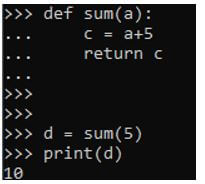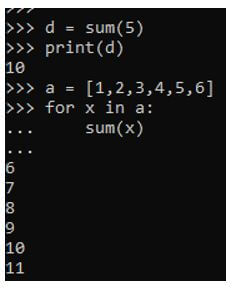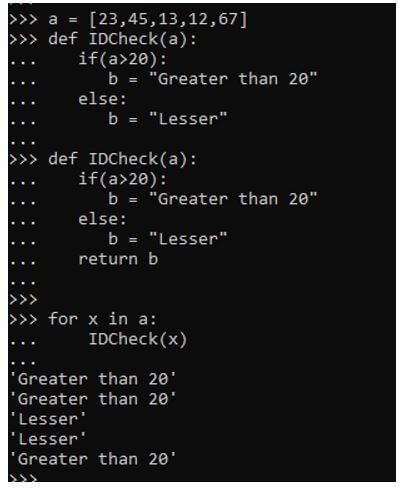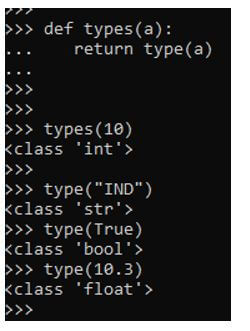Introduction to Python User Defined Functions
Python User Defined Functions is a function in Python that allows users to write custom logic that the user defines. It is a feature in Python that defines the custom logic that is passed over the Python data frame and transforms the data accordingly. The UDF consists of custom-defined logics with a set of rules and regulations that can be passed over the data frame and used for analysis purposes.
Python allows the user to define the logic in a function and further can be used by registering it in the Python data model. Here we will try to analyze the various ways of using the user-defined function operation Python.
Syntax
Given below is the syntax of Python User Defined Function:
def sum(a):
c = a+5
return c
d = sum(5)
print(d)Explanation:
- sum: The sum function defined that will be used further as UDF.
- d: Passing the Python function with the input parameter needed.
Output:
Working of User-Defined Functions in Python
Let us see how user defined functions work in Python:
- The user defined functions are the function that grants the user the access and write their own custom logics. This UDF is registered in Python session and can be used in the code function in Python.
- The def is used to declare the function in Python. The custom logic is defined inside the Python UDF function, which can be used further as the user defined function and can be applied to elements needed.
- The function takes up arguments called as a parameter in Python that works as the input for the logics to be used in. This user defined function can take up some variable and returns the result that can be stored back in a variable in Python and then can be used for analysis function.
- Once defined, the functions can be used further anytime in a Python session that can accept multiple inputs further and process results.
- This makes the code encapsulated, and the reuse of code becomes easier in the Python library.
Examples of Python User Defined Functions
Given below are the examples of Python User Defined Functions:
Example #1
Let’s start by creating a simple function in Python.
Let us define a function that takes one parameter and adds up the column. We will use this function as the UDF in Python and analyze the result. This function accepts one variable and then returns the sum as the output.
Code:
def sum(a):
c = a+5
return cLet us pass this user defined function to list in Python and analyze the result further.
a = [1,2,3,4,5,6]
for x in a:
sum(x)Output:
Example #2
Let us check one more example and pass this UDF to python code.
Code:
a = [23,45,13,12,67]
def IDCheck(a):
if(a>20):
b = "Greater than 20"
else:
b = "Lesser"
def IDCheck(a):
if(a>20):
b = "Greater than 20"
else:
b = "Lesser"
return b
for x in a:
IDCheck(x)Output:
Example #3
Let’s try to analyze one more example where we can find the data type of variable in Python. Then, we will create a UDF function and try to find out the data type of it.
Code:
def types(a):
return type(a)
types(10)
#This print the Type as INT.
type("IND")
#This returns the Data Type as String.
type(True)
This returns the Data Type as bool.
type(10.3)
#This as Float.
#This UDF can be used to get the data type of function in Python.
Output:
Conclusion
From the above article, we saw the working of user defined functions in Python. From various examples and classification, we tried to understand how this user defined function works in Python and what is its use at the programming level. The various methods used showed how it eases the pattern for data analysis and a cost-efficient model for the same. We also saw the internal working and the advantages of user defined function in Python data frame and its usage in various programming purposes. Also, the syntax and examples helped us to understand much precisely over the function.
Recommended Articles
This is a guide to Python User Defined Functions. Here we discuss the introduction, working of user defined functions in python and examples. You may also have a look at the following articles to learn more –






